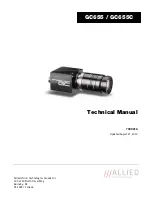
18
4. SAVING AND RECALLING IMAGES
If there is a micro SD memory card in the drive, it is possible to
store
, then
recall
the current image and measurements
displayed.
4.1. How are the image files named?
The camera has two objectives, one for infrared images, the other for entering a photograph in the visible domain. In
consequence, when an image is recorded, two files are created, one for the infrared image, named
"yyyymmdd_hhmmss_IR.PNG", the other for the visible image, having the same name but without the IR extension
("yyyymmdd_hhmmss.PNG"), where yyyymmdd_hhmmss is the date and time of acquisition of the image (the operator must take
care to reset the system date and time in advance, see § 1.5.2.
Changing the camera's date and time
).
A third file may be added to the other two if a Bluetooth headset is connected to the camera and the operator accepts the
proposal to create a vocal message (see § 4.4.
Adding a vocal remark
). This file will be given the same name as the associated
IR image, with the extension .WAV instead of .PNG (e.g. yyyymmdd_hhmmss_IR.WAV).
When the image is frozen, it is possible to make several backups of the same image (addition of cursors, change of palette, etc.).
These are referred to as "derived" images: to differentiate these infrared images, which have the same date of acquisition, an
index from "a" to "z" is added after the date (e.g. 20141020_131254a_IR.PNG). When all indexes from "a" to "z" have been used,
the index "z" is re-used and the file that already bears this name is overwritten by the new one.
As for the visible image, it does not change and so is not duplicated. A single visible image can therefore be associated with
several infrared images (when erasing visible images other than via the camera's file manager, take care not to create orphan IR
images). Here again it is possible to add a vocal message, which will have the same name as the IR image (e.g.
20141020_131254a_IR.WAV).
4.2. Saving an image
It is possible to save an image when there is a micro SD memory card in the drive.
In normal operation
if the function associated with the trigger is Aim or Freeze (see § 1.5.4.
Changing the
function associated with the camera's trigger
), it is first necessary to stop acquisition
(if this has not already been done, press
F2
) to freeze the image.
Either the
F2
or the
F3
key then takes on the function
, allowing backup of the
current image in the working directory. If the trigger is assigned to the Save function,
each press freezes the image (if it is not already frozen) and records the frozen image
in memory.
If acquisition is stopped, each further press creates a new "derived" image (same date
of acquisition), differentiated by the addition to its name of an index (see § 4.1.
How
are the image files named?
)
If an image is recalled
it is possible to create a new image (derived, because from the same acquisition) by
selecting the item
in the Recall menu; a new index (see § 4.1.
How are the image
files named?
)
will be used, since the date of acquisition is unchanged.
When the backup is terminated, a message reports the name of the file that has just
been created.
If a Bluetooth headset is connected (see § 6.2.2.
How to connect a headset
) a second
message proposes adding a vocal remark to this file.
Summary of Contents for C.A 1954 DiaCAm2
Page 1: ...GB User s manual C A 1954 THERMAL CAMERA...
Page 37: ...APPENDIX I Menu tree 1 3...
Page 38: ...APPENDIX I Menu tree 2 3...
Page 39: ...APPENDIX I Menu tree 3 3...
Page 42: ...X04696A02 Ed 1 11 2017...
















































